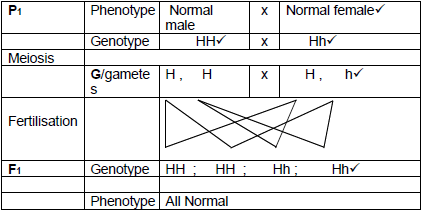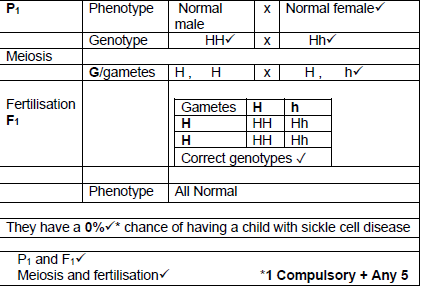Life Sciences Paper 2 Memorandum - Grade 12 September 2021 Preparatory Exams
Share via Whatsapp Join our WhatsApp Group Join our Telegram GroupPRINCIPLES RELATED TO MARKING LIFE SCIENCES
- If more information than marks allocated is given
Stop marking when maximum marks is reached and put a wavy line and ‘max’ in the right-hand margin. - If, for example, three reasons are required and five are given
Mark the first three irrespective of whether all or some are correct/incorrect. - If whole process is given when only a part of it is required
Read all and credit the relevant part. - If comparisons are asked for but descriptions are given
Accept if the differences/similarities are clear. - If tabulation is required but paragraphs are given
Candidates will lose marks for not tabulating. - If diagrams are given with annotations when descriptions are required
Candidates will lose marks. - If flow charts are given instead of descriptions
Candidates will lose marks. - If sequence is muddled and links do not make sense
Where sequence and links are correct, credit. Where sequence and links are incorrect, do not credit. If sequence and links become correct again, resume credit. - Non-recognised abbreviations
Accept if first defined in answer. If not defined, do not credit the unrecognised abbreviation but credit the rest of the answer if correct. - Wrong numbering
If answer fits into the correct sequence of questions but the wrong number is given, it is acceptable. - If language used changes the intended meaning
Do not accept. - Spelling errors
If recognisable, accept the answer, provided it does not mean something else in Life Sciences or if it is out of context. - If common names are given in terminology
Accept, provided it was accepted at the national memo discussion meeting. - If only the letter is asked for but only the name is given (and vice versa)
Do not credit. - If units are not given in measurements
Candidates will lose marks. Marking guideline will allocate marks for units separately. - Be sensitive to the sense of an answer, which may be stated in a different way.
- Caption
All illustrations (diagrams, graphs, tables, etc.) must have a caption. - Code-switching of official languages (terms and concepts)
A single word or two that appear(s) in any official language other than the learners’ assessment language used to the greatest extent in his/her answers should be credited if it is correct. A marker that is proficient in the relevant official language should be consulted. This is applicable to all official languages.
MEMORANDUM
SECTION A
QUESTION 1
1.1
1.1.1 C
1.1.2 D
1.1.3 A
1.1.4 B
1.1.5 D
1.1.6 A
1.1.7 C
1.1.8 B
1.1.9 B
1.1.10 B (10 x 2) (20)
1.2
1.2.1 Phenotype
1.2.2 Autosomes
1.2.3 Chiasmata /chiasma
1.2.4 Gene
1.2.5 Transcription
1.2.6 Cloning
1.2.7 Homologous chromosomes
1.2.8 Locus (8)
1.3
1.3.1 B only
1.3.2 Both A and B
1.3.3 B only (6)
1.4
1.4.1 Meiosis (1)
1.4.2 Metaphase 1 (1)
1.4.3
- B (1)
- F
- D and E
(Mark first TWO only) (1) (2)
1.4.4 4 / four (1)
1.4.5 Sperm / (not gamete) (1)
1.5
1.5.1 Million years ago (1)
1.5.2
- C /A (1)
- A (1)
- B (1)
1.5.3 Various hypotheses relating to evolution have been tested and verified
over time /has undergone several tests and is supported by evidence (1)
1.5.4
- Biogeography
- Genetics
- Modification by descent /homologous structures (Any 3 x 1)
(Mark first THREE only) (3)
TOTAL SECTION A: 50
QUESTION 2
2.1
2.1.1 A – Centromere (1)
2.1.2 DNA Replication (1)
2.1.3
- The DNA molecule unwinds
- And unzips / the weak hydrogen bonds break
- Each strand acts as a template
- Free floating nucleotides in the nucleoplasm
- Join to their complementary strand/base pair / (T-A; C-G)
- Forming two identical strands of DNA (Any 4 x 1) (4)
2.1.4
- Produce two exact copies of the cells/ DNA /chromosomes
- So that each new cell formed in mitosis has the exact genetic material/ same amount of DNA as the parent cell /chromosomes. (2)
2.2
2.2.1 Set 2 (1)
2.2.2
- All the bands of the baby that don’t match father 2 match mother 2
OR - All the DNA bars of the baby match that of father 2 and mother 2
OR - The other parents’ bands do not match all the bands of the baby (2)
2.2.3
- blood
- skin cell
- hair cell
- saliva
Mark first TWO only (Any 2 x 1) (2)
2.2.4
- Biological evidence in forensic investigations /crime scenes/ identify criminals
- Tracing missing persons
- Identify dead persons /animals
- Identifying genetic disorders
- Matching tissues for organ transplants
- Establishing family relations
Mark first TWO only (Any 2 x 1) (2)
2.3
2.3.1 The sickle shape red blood cells cause blockages in the blood vessels leading to damage of vital organs / transport less oxygen leading to less energy/ anaemia (1)
2.3.2 Stem cell are undifferentiated cells that have the potential to form any tissue or organ (2)
2.3.3
- CUU (1)
- Glycine (1)
- If Thymine changes to Adenine
- The mRNA/codon will be GUG instead of GAG
- The tRNA/anticodon will be CAC instead of CUC
- Therefore, the amino acid will be Valine
- instead of Glutamine (4)
2.3.4
They have a 0%* chance of having a child with sickle cell disease
- P1 and F1
Meiosis and fertilisation
Any 5 + *1 Compulsory OR (6)
(6)
2.4
2.4.1 Karyogram / Karyotype (1)
2.4.2
- Chromosome pair 23 has
- two X chromosomes /XX/ chromosomes are the same size (2)
2.4.3
- Because there is a double set of chromosomes / 46 chromosomes/ it is diploid/ homologous pairs
- and not a single set of chromosomes / not 23 chromosomes/ not haploid (2)
2.4.4 Down’s Syndrome / trisomy 21 (1)
2.4.5
- Homologous chromosome pair 21
- does not separate /non-disjunction
- This will lead to one gamete having two copies of chromosome 21
- When this gamete fuses with a normal gamete
- the resulting zygote will have an extra copy of chromosome 21 / 3 copies of chromosome 21 (Any 3 x 1) (3)
2.5
2.5.1 Dihybrid Cross (1)
2.5.2 There are two different characteristics being crossed (1)
2.5.3
- bbtt (2)
- Both Black and no white patches
OR
Parent 1 - Black and no white patches
Parent 2 – Black and no white patches (2)
2.5.4
- Since black coat is controlled by a dominant allele
- the kitten could be homozygous/ BBtt or heterozygous /Bbtt (2)
2.5.5
- The pair of alleles on homologous chromosomes separate
- during meiosis /anaphase/ gamete formation, so that
- only one allele of each pair is present in the gamete / offspring can acquire one allele from each parent (3)
[50]
QUESTION 3
3.1
3.1.1 Graph showing the number of monarch butterfly colonies from 1994 to 2010 (1)
3.1.2
- Use of herbicide (1)
- Number of Monarch butterfly colonies (1)
3.1.3
- The number monarch butterfly colonies decreased from 1996
- before herbicides were used in 1998. (2)
3.1.4
- An organism whose DNA/genome has been modified
- to express a desired characteristic (2)
3.1.5
- Less competition between crop and weeds / there will be more yield
- leading to an increase in the farmers’ profit (1)
3.2
3.2.1 There was not enough food for them to eat (1)
3.2.2
- Lizards were separated by water
- and therefore, there was no interbreeding (2)
3.2.3
- On the island there was variation in the size of Gymnodactylus amarali /lizards
- Some lizards had smaller heads while others had larger heads
- When there were more larger termites on the islands
- Those with smaller heads died out since they could only eat small termites
- Those with larger heads survived could eat large termites
- they reproduced and passed on their characteristic of larger heads to their offspring
- Eventually over time there was a greater proportion of lizards with larger heads (Any 5 x 1) (5)
3.2.4
- If the island species can interbreed with the mainland species
- and produce fertile offspring they are the same species /if they do not produce fertile offspring, they are not the same species (2)
3.1
3.3.1 Homo sapiens (1)
3.3.2
- to be able to tear / bite/ chew
- raw food (2)
3.3.3 Table
| Humans | Gorilla | |
| 1 | Larger cranium /brain | Smaller cranium /brain |
| 2 | Flat face / Forehead slopes less backwards | Face sloping / Forehead slopes more backwards |
| 3 | Brow ridges are less pronounced | Brow ridges are more pronounced |
| 4 | Less protruding jaws / prognathous | More protruding jaws / prognathous |
| 5 | Lower jaw has a well-developed chin | Lower jaw has a poorly developed chin |
(Mark first THREE only) Table + (Any 3 x 2) (7)
3.3.4
- Opposable thumbs
- Freely rotating arms
- Elbow joints allowing rotation of forearm
- Rotate hands at least 180°
- (Flat) nails instead of claws /bare fingertips
- Five digits/ pentadactyl
(Mark first TWO only) (Any 2 x 1) (2)
3.4
3.4.1
- Australopithecus
- Ardipithecus (2)
3.4.2 4 mya (1)
3.4.3 (4.5 – 1) = 3.5 mya (2)
3.4.4
- The foramen magnum has moved to the base of the skull / is in a more forward position so that the head can be held vertically. / spinal cord can be in line with the brain/ spine to enter the skull vertically
- The position of the pelvic girdle moved to under/the bottom of the core body so it is suitable to carry the weight of the upper body
- The pelvis has become more cup shaped/wider and shorter which makes it suitable to carry the core/weight of the upper body / for better distribution of upper body weight
- The spine became S- shaped / greater lumbar curvature in spine for better balance/to support the upper body weight
Mark first TWO only (Any 2 x 2) (4)
3.4.5
- Australopithecus africanus (1)
- Sterkfontein Caves (1)
- Robert Broom / John T Robinson (1)
3.5
3.5.1 Modern humans originated in Africa and then migrated to other continents (2)
3.5.2 Fossil evidence mitochondrial DNA / mtDNA Mark first TWO only (2)
3.5.3 Americas (1)
3.5.4 (200 000 – 45 000) years = 155 000 years (2)
[49]
TOTAL SECTION B: 100
GRAND TOTAL: 150